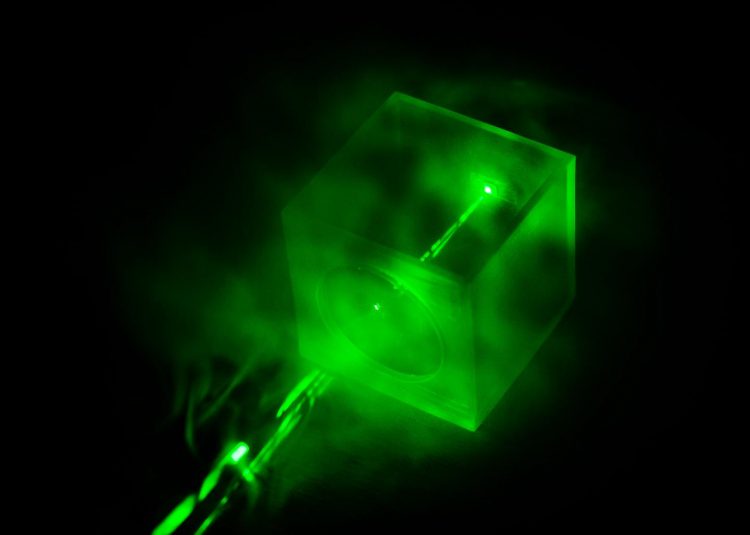The new prototype device is portable and suitable for rapid deployment by agencies to identify airborne hazards, such as from tiny gas molecules like sulphur dioxide. It can also identify larger compound molecules such as benzene, known to be harmful to human health.
It can provide real-time monitoring of air quality such as during haze outbreaks, and assist in the detection of gas leaks and industrial air pollution.
Developed by a research team led by Associate Professor Ling Xing Yi at the School of Physical and Mathematical Sciences, the new technology was reported last month in science journal ACS Nano.
Current methods of identifying gases in the air use a laboratory technique called Gas Chromatography – Mass Spectrometry (GC-MS), which is reliable but requires tedious sample collection and takes between a few hours and a few days to obtain results from air samples.
Emergency scenarios require a fast and ongoing analysis of potential air contamination, such as following a natural disaster, chemical spill or illegal dumping of toxic waste, so that emergency responders can take appropriate action.
How the new device works
The new device uses a small patch made of a special porous and metallic nanomaterial to first trap gas molecules. When a laser is shone on it from a few metres away, the light interacts with the gas molecules, causing light of a lower energy to be emitted. When analysed, it gives a spectroscopic readout in the format of a graph chart.
The spectroscopic readout acts like a “chemical fingerprint” corresponding to various chemicals present on the patch. The whole process takes about 10 seconds to complete.
These chemical fingerprints from the sample are referenced against a digital library of fingerprints to quickly determine what chemicals have been detected.
Known as Raman spectroscopy, this is a long-established technique for identifying chemical substances. Typically, it has been used only on solid and liquid samples, since gaseous chemicals are too dilute for the laser and detector to pick up.
To overcome this limitation, Assoc Prof Ling and her PhD student Mr Phan Quang Gia Chuong developed a special nanostructure made from a highly porous synthetic material known as a metal-organic framework, which actively absorbs and traps molecules from the air into a 'cage'.
This nanostructure also contains metal nanoparticles, which boost the intensity of the light surrounding the molecules. The result is a million-fold enhancement in the Raman spectroscopy signals, which allows for the identification of the trapped molecules.
Assoc Prof Ling said the genesis of the invention was sparked by an incident in Singapore, where there were reports of a strong gas-like odour over certain parts of the island in 2017. The cause was only determined a few days later, and was traced to volatile organic compounds released by factories outside of Singapore.
Together with her husband, Dr Phang In-Yee, a project leader and scientist at the Institute of Materials Research and Engineering (IMRE), they conceptualised the idea of identifying gases instantly from a distance.
“Our device can work remotely, so the operation of the laser camera and analysis of chemicals can be done safely at a distance. This is especially useful when it is not known if the gases are hazardous to human health,” explains Assoc Prof Ling, Head of the Division of Chemistry & Biological Chemistry at NTU.
The laser was tested in experiments to work up to 10 metres away and can be engineered to reach further distances. Another possible method is to use the chip to capture gases, which is subsequently analysed with a laser.
Ultra-sensitive and accurate result
In experiments, the team showed that the device can identify airborne molecules such as polyaromatic hydrocarbons (PAH), including naphthalene and derivatives of benzene, a family of colourless industrial air pollutants known to be highly carcinogenic.
It can detect PAHs at parts-per-billion (ppb) concentrations in the atmosphere as well as performing continuous monitoring of the concentration of the different types of gases like carbon dioxide (CO2) in the atmosphere, which could be a useful application in many industrial settings.
The laser used in the device has an energy intensity of 50 miliwatts, more than seven times weaker than in other applications of Raman spectroscopy. This makes the system safer to operate and more energy efficient.
Through NTUitive, NTU's innovation and enterprise company, the team has filed for a patent and is now commercialising the technology for use in pollution monitoring, chemical disaster response, as well as other industrial applications.
###
Notes to Editor:
Paper titled “Tracking Airborne Molecules from Afar: Three-Dimensional Metal-Organic Framework-Surface-Enhanced Raman Scattering Platform for Stand-Off and Real-Time Atmospheric Monitoring”, published in ACS Nano, 13 Sept 2019.
Photos of the research team and their invention can be downloaded here. Credit to NTU Singapore.
Media contact:
Lester Kok
Assistant Director
Corporate Communications Office
Nanyang Technological University
Email: lesterkok@ntu.edu.sg
About Nanyang Technological University, Singapore
A research-intensive public university, Nanyang Technological University, Singapore (NTU Singapore) has 33,000 undergraduate and postgraduate students in the Engineering, Business, Science, Humanities, Arts, & Social Sciences, and Graduate colleges. It also has a medical school, the Lee Kong Chian School of Medicine, set up jointly with Imperial College London.
NTU is also home to world-class autonomous institutes – the National Institute of Education, S Rajaratnam School of International Studies, Earth Observatory of Singapore, and Singapore Centre for Environmental Life Sciences Engineering – and various leading research centres such as the Nanyang Environment & Water Research Institute (NEWRI) and Energy Research Institute @ NTU (ERI@N).
Ranked 11th in the world, NTU has been placed the world's top young university for the past six years. The NTU Smart Campus is frequently listed among the Top 15 most beautiful university campuses in the world and it has 57 Green Mark-certified (equivalent to LEED-certified) building projects, of which 95% are certified Green Mark Platinum. Apart from its main campus, NTU also has a campus in Novena, Singapore's healthcare district.
For more information, visit http://www.







